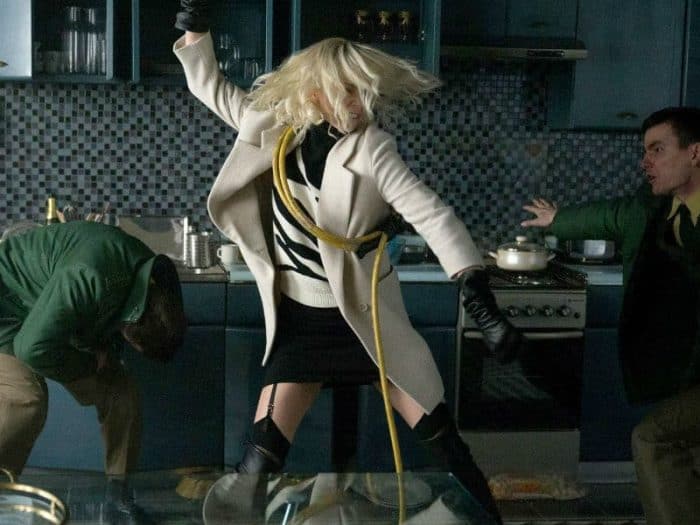
La Femme Nikita (1990)
While it doesn’t really have anything to do with the Cold War, Luc Besson’s stylish action movie (also known simply as Nikita) was made the year in which Atomic Blonde is set, shot ahead of the fall of the Wall but released after. It also follows one of the earliest female action protagonists, surely one of the precursors to Theron’s character in the new movie. The titular Nikita, played by Anne Parillaud, is a government assassin and operative trained to be a perfect weapon after being saved from a life in prison.
She’s also, like Theron’s Lorraine, a beautiful, sexy femme fatale who finds herself in the midst of action wearing the wrong sort of outfit — yet both still hold up pretty well despite having to maneuver in a dress. Nikita and Lorraine aren’t very similar as characters otherwise, though, and anyone making the claim that Atomic Blonde is La Femme Nikita meets John Wick is merely referencing the former because it features a kick-ass woman and takes place around the same time and in the same continent.
Hedwig and the Angry Inch (2001)
Like Atomic Blonde, John Cameron Mitchell’s glam musical does use the fall of the Berlin Wall as a backdrop for its story. The title character of Hedwig and the Angry Inch (played by Mitchell) is a transgender woman, although because of a botched gender reassignment operation her ambiguous genitalia (her “angry inch”) makes for a complicated gender identity. There are plenty of analogies made between Hedwig’s identity and that of Berlin during reunification, particularly in her song lyrics:
“The hole closed up, the wound healed,” from “Angry Inch,” “sewed the wound up” from “Origin of Love,” and “all sewn up” in “Exquisite Corpse” are some of the metaphors to be found. And then there’s the literal link in “Tear Me Down,” which includes the words “now that it’s gone, we don’t know who we are anymore. Ladies and gentlemen, Hedwig is like that wall, standing before you in the divide between East and West, slavery and freedom, man and woman, top and bottom.” There’s also mention of the Berlin divide in “Hedwig’s Lament.”
Goodbye, Lenin! (2003)
The best movie set amidst the fall of the Berlin Wall and its aftermath is this comedy about a brother and sister who try to keep the news of reunification and capitalism in the East from their ailing mother. She had gone into a coma in October 1989, one month before the Wall fell, after seeing her son arrested for demonstrating against the government. She woke up the following summer. A doctor says that another shock, especially one as big as learning of the changes to her beloved GDR, would probably kill her.
So her kids do everything they can to shield her from the news. They have to keep her windows shut so she doesn’t see a giant Coca-Cola advertisement outside (there’s Coke signifying the West and capitalism again), they produce fake state news programs, and they seek out her favorite delicacies that have disappeared in the wake of more brand name options filling up supermarkets. I’m not usually a fan of plots where escalating deceit delivers ramped-up hilarity, but this satirical feature has great reason for the idea. Also, if you love Amelie, you’ll at least enjoy Yann Tiersen’s similar score for Goodbye, Lenin!
This Ain’t California (2012)
For a documentary pick, there a few I could recommend for more background or connection to the Berlin Wall. There are the expository PBS types, such as The Wall: A World Divided and its follow-up, After the Wall: A World United. There’s Ross McElwee’s more subjective Something to Do with the Wall. There’s the magnificent rabbits-in-the-Wall mid-length doc Rabbit a la Berlin. There’s the Up series-like The Children of Golzow, which actually started before the more famous doc franchise and follows characters from the time of the Wall’s erection through the German reunification. And there’s the recent 1989, which shows how the fall of the Iron Curtain wasn’t just happening in Berlin at that time.
But I think This Ain’t California reflects the tone and characters of Atomic Blonde during the fall of the Wall the best. Never mind whether it’s a real documentary or not (I go by the filmmakers’ intentions and the acceptance of it being a work of nonfiction in nontraditional terms). If you notice all the punks and skaters in the new movie, especially around Alexanderplatz, those are the people This Ain’t California is about. The doc presents a history of skater culture in the GDR in the ’80s through the fall of the Wall, as recalled by a group of friends reunited for a funeral (in my review I called it “The Big Chill meets Dogtown and Z-Boys“). The guy who died isn’t real, nor are other characters, but the gist is truthful. And the soundtrack is definitely more authentic to the place and time than Atomic Blonde‘s.
Related Topics: Movie DNA
